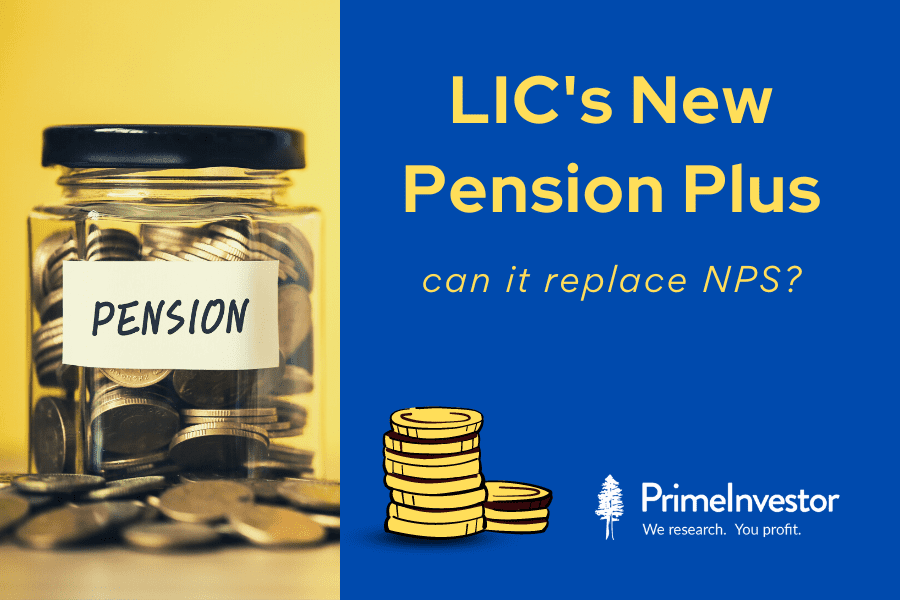In September 2022, LIC launched a new pension product. LIC’s New Pension Plus – LIC’s NPP(plan number: 867) with features similar to NPS. In the case of NPS, the default retirement age is 60. But in the case of LIC’s NPP, you can choose the policy maturity age and this can be as early as 35. So, does the LIC’s NPP score over NPS? Let’s find out!
Note: In this review, we’re looking into the suitability of LIC’s NPP as a long-term investment product and comparing it with alternatives. Only the features relating to this aspect have been considered for this review. To view all the features, refer to the policy brochure.

About the policy
LIC’s NPP is a unit linked, non-participating pension plan. This means the returns from the product are market linked and do not depend on the performance of LIC.
- The minimum age to invest is 25, maximum is 75.
- The minimum vesting age (age at which policy begins to pay pension) is 35. Maximum is 85.
- The minimum duration for the policy term is 10 years. Maximum is 42 years.
- There are both single premium and regular premium options. In the case of regular premium, the premium paying term is equal to the policy term.
- The policy provides 4 fund options with varying levels of equity/debt allocation. You can choose any of the 4-fund options and switch between them.
- At the vesting date, you can use the entire proceeds to buy an annuity or commute upto 60% of the proceeds and buy an annuity with balance 40%.
- The policy allows buying annuity from other insurers; in that case, only upto 50% can be commuted and rest should be used to purchase annuity.
- The annuity can be immediate or deferred.
- The policy allows partial withdrawals during the policy period
- The vesting date (end of policy period) can be extended subject to some conditions
Death benefit: The death benefit on this policy is the higher of:
- 105% of premium paid
- Market value of the investments under the policy
The policy is locked in for the first 5 years. After the lock-in period, it can be surrendered at any time. At the time of surrender, at least 40% of the proceeds should be used to buy an annuity.
Investment fund options
LIC’s NPP allows 4 options for investments with varying levels of equity and debt. They are as follows:
Investors can switch between funds, but switches are only allowed in the following combinations. Upto 4 switches per year are free. Thereafter, Rs.100 will be charged for each switch.
Features affecting LIC's NPP returns
#1 Charges
There are 3 main heads under which charges are levied by the policy. They are:
Premium allocation charge: This is directly deducted from the premium paid. In the case of regular premium policies, this charge is as high as 7% for the first year in offline mode, going down to 3.5% the 6th year onwards. For the online policy, it is 2.5% in the first year, reducing to 1% finally.
Policy administration charge: This is levied by cancelling units at the beginning of each month for the first 5 years.
Note: The above tables for policy administration charges under annual premium payment mode. Charges under monthly, quarterly, and half yearly payments may slightly differ. For full details, refer to the policy brochure pages 17
Fund management charge: This is 1.35% for all 4 fund options. This is levied by adjusting the NAV (similar to mutual funds or NPS).
There are some other charges arising out of special situations, but these are not applicable under normal circumstances. To see the full list of charges applicable, see the policy brochure pages 16 to 20.
#2 Guaranteed additions
Another feature affecting the returns of LIC's NPP is ‘guaranteed additions’. The policy will add a certain percentage of annual premium at the end of 6th, 10th, and through 11th year to expiry of policy.
How do the fees and guaranteed additions get applied?
Thanks to all of the above, LIC's NPP is left with a complex structure of fees and benefits. When you invest an amount, first the premium allocation charge is deducted directly from it. The remaining sum helps you buy units of the scheme at the day’s NAV. The NAV is calculated after deducting fund management charges on a daily basis. But policy administration charges are applicable for the first 5 years and they are levied by cancelling the units you accumulate. This will reduce your returns but won’t reflect in the NAV.
Returns from the policy are not wholly market-linked either. After 5 years are completed, some of the returns come to you by way of guaranteed additions, on the premium (not corpus). The additions fetch you units at the NAV of the day. Therefore, tracking how this policy is faring will entail keeping track of the number of units, charges and NAV.
Do note that the fees are maximum in the first 5 years and the guaranteed additions are not applicable in the first 5 years.
How does LIC's NPP compare with NPS?
We have to compare the policy with NPS based on 3 heads. Taxation, Fees and Features.
Taxation
Here NPS clearly scores both at the time of investment and at the time of maturity.
At the time of investing, both NPS and LIC's NPP allows tax exemption under section 80C for upto Rs 1.5 lakh. But NPS also allows additional tax exemption of Rs 50,000 under section 80CCD(1B).
In the case of NPS, at the time of maturity, 60% of the corpus is tax free. During the investment period, an NPS subscriber is allowed to change the fund options and change fund managers without any tax liability.
For LIC’s NPP; the taxation during the investment period and maturity is dependent on the nature of the portfolio and switches between the fund options.
As per recent changes to ULIP taxation (under Finance Act 2021) which applies to LIC’s NPP, the maturity proceeds are tax free only if annual premiums are less than 10% of sum assured of the policy. Since this is not the case for LIC’s NPP, the section 10(10D), which gives tax exemption for ULIPs, is not applicable to LIC’s NPP. For the policies where section 10(10D) is not applicable, the tax is calculated as capital gains as below:
For equity based portfolios, long term capital gain tax is 10% above Rs 1 lakh. Short term capital gain is taxed at 15%.
For debt based portfolios, long term capital gain tax is 20% with indexation. Short term capital gain is added to income for tax computation.
Please note that taxation of debt funds has undergone a change. Indexation benefit will no longer be available for investments made from April 1, 2023 onwards. You can read all about this change in our article, ‘Tax changes in mutual funds: How to manage your investments now‘.
While ‘long term’ is defined as 1 year in the case of equity and 3 years in the case of debt.
Do note that in case you switch funds during the policy period, the tax calculation becomes complicated as each switch can trigger a capital gains tax liability. This aspect could see tax tweaks in the future. (Read more on ULIP taxation and Finance act 2021 here: Taxmann: Taxation of ULIPs, Taxmann: FAQ on taxation of ULIPs)
Fees
Here also NPS scores over LIC's NPP. The maximum fund management charges of NPS, 0.09% is just a fraction of the charges of LIC's NPP fund management charge at 1.35%. Unlike LIC's NPP; NPS does not have a premium allocation charge or policy administration charges. NPS do have other charges like subscriber registration charges, annual maintenance charges, persistency charges etc. However these are low compared to charges applicable to LIC’s NPP. If you opt to open the NPS via a central record keeping agency (CRA) instead of a point of presence (POP), these charges will be on the lower side. See all NPS charges applicable here.
See the illustration in the section 'Investment growth: LIC's NPP vs NPS' for more details on applicable charges.
Features
In the case of NPS, the default retirement age is set as 60. If one has to close NPS before that, it is mandatory to purchase an annuity with 80% of the proceeds. In the case of LIC's NPP, one can choose the vesting age (age at policy maturity) at the time of joining the policy. It also allows easy closure at any time after the lock-in period of the first 5 years. You can commute upto 60% of the surrender value and it is mandatory to invest at least 40% of the proceeds to buy an annuity. This makes LIC’s NPP more flexible than NPS for folks who have early retirement plans.
On the other hand, NPS allows you to increase or decrease your annual investments as you wish. This allows the investor to vary his investments based on his life situation and income levels. One may start with a modest contribution and can increase investments in NPS as the income increases. In the case of LIC's NPP though, once you decide on an annual premium you need to stick to it for the whole duration of the policy.
Investment growth: LIC's NPP vs NPS
Features apart, your final decision on whether to opt for LIC’s NPP or NPS would depend on the effective returns. Given the complex structure of charges and returns, an IRR is the best way to gauge returns to the investor. Let’s look into how the internal rate of return compares among LIC's NPP and NPS.
Please note that this comparison is premised on both LIC’s NPP and NPS delivering similar portfolio performance. For LIC's NPP, we use a calculation based on the benefit illustration with an assumed 8% return on the underlying investment, applying charges and guaranteed additions. For NPS, we use the same 8% return with NPS charges applied on top of it.
For a period of 20 years, with an underlying investment generating 8% uniform annual return;
IRR of LIC's NPP regular payment, offline mode would be 6.08%
IRR of LIC's NPP regular payment, online mode would be 6.32%
IRR of NPS with yearly fixed payment would be 7.86%
See the spreadsheet LIC's NPP vs NPS for calculations.
As you can see, the higher charges reduce investor’s share of returns in the case of LIC's NPP despite the guaranteed additions. NPS being a lower cost product, gives returns much closer to the portfolio returns.
Note: In the case of NPS, not all charges used in the calculation will be applicable for online mode of subscription. See this page for more details on NPS charges.
How does it compare with mutual Funds?
Being a long term investment product, LIC's NPP can be compared with mutual funds too. In this case, an investor is assumed to hold mutual funds until the desired retirement date and then uses the accumulated corpus to buy an annuity or generate income by any other means as he/she wishes.
Obviously, mutual funds score big on the flexibility aspect over LIC's NPP as there is no restriction on how much one invests, at what time intervals or what he/she does with the accumulated corpus on maturity. You may choose to invest in a debt MF and set up a tax efficient SWP at retirement, instead of buying into a low return-inflexible annuity product.
The taxation aspect of mutual funds is similar to that of LIC’s NPP as per current laws. Do note that at the time of investment, only the ELSS category of mutual funds are eligible for tax deduction under section 80C.
MFs score over LIC's NPP on fees. See a comparison below:
For a period of 20 years, with the underlying investment generating 8% annual returns.
IRR of LIC's NPP single payment - offline mode would be 6.61%
IRR of LIC's NPP single payment - online mode would be 6.72%
IRR of mutual fund for a lumpsum investment would be 7.10%
See the spreadsheet LIC's NPP vs MF for calculations.
The calculation assumes a single investment of Rs.10 lakh is done on both LIC's NPP and mutual funds. Both are held for the next 20 years. The mutual fund expense ratio is assumed to be the average expense ratio of flexi cap funds - direct plans, at 0.833%.
Conclusion
While all of the above calculations assume that LIC would generate the same returns as NPS or MFs on equity and debt, the reality is that LIC has not been a great active manager of either equity or debt in the past. LIC’s equity portfolio has shown a distinct tilt towards PSU stocks which have been underperformers over the long term.
Its debt portfolio has featured higher NPAs than most actively managed debt funds. The fact that LIC’s product portfolio has been dominated by low-return traditional plans, has also set a low bar on its portfolio performance and made it tough to benchmark its active management skills against other more competitive vehicles such as MFs or even ULIPs.
This suggests that NPS or even index funds may make for a better substitute for investors seeking a market-linked accumulation avenue for retirement.
LIC's NPP is an investment product with mandatory purchase of annuity with part of the maturity proceeds. Even though it resembles NPS, the additional tax advantages, lower fees, and ability to increase contributions make NPS a better product for retirement funding. For those who can manage the investment themselves, a mutual fund portfolio with a SWP on maturity, makes more sense than LIC’s NPP.







3 thoughts on “LIC’s New Pension Plus – can it replace NPS?”
Super analysis, kudos.
Super! Nicely articulated the points!
Fantastic analysis! Thank you
Comments are closed.